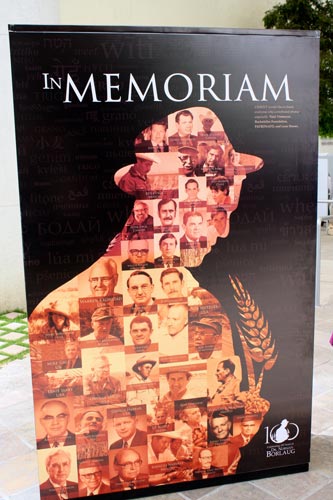By Brenna Goth/CIMMYT
Check out the Storify recap here.
Speakers addressed visions for the future of wheat and agriculture research and improvement during the final day of the Borlaug Summit on Wheat for Food Security.
The challenges related to producing enough food for the global population in 2050 are immense, speakers agreed, but complex solutions are possible. Wheat will play a large role in meeting those goals.
“I believe, in the bottom of my heart, that we do have the tools and capabilities to achieve the incredible goal of doubling food supply in a sustainable way,” said Robb Fraley, executive vice president and chief technology officer for Monsanto.
Fraley spoke about the future of agriculture technology and the partnerships that will make its implementation possible. Changing how to breed and select crops and deciding where they are grown are all ways forward.

Multi-faceted solutions to address ever-evolving problems are key, according to Fraley. Computer-modeled and statistically based data science, for instance, can optimize farm management practices to improve productivity. Advice can be distributed to farmers in most countries using cell phones.
“These tools, which have virtually no barrier to adoption, will be transformational,” Fraley said.
Biotechnology is also changing the way people think about breeding crops, Fraley said. About 17 million farmers in nearly 30 countries are using biotech crops.
Public-private partnerships can help bring this technology to farmers. For example, Water Efficient Maize for Africa – a partnership including Monsanto and CIMMYT – is using genetics from multiple sources to produce biotech and non-biotech maize hybrids.
“I think this kind of model can work for every crop,” Fraley added.
Opposition to genetically modified (GM) crops is a complicated movement with important policy implications, said Robert Paarlberg, professor of political science at Wellesley College. He added that the near future of staple crops is “not particularly bright” because the gene revolution hasn’t reached farmers’ fields.
The gene revolution faces institutional barriers never posed to the Green Revolution, Paarlberg presented. Waning donor commitments in the 1990s tasked private companies with promoting GM crops. Anti-corporation activists then began to speak out against the technology.
GM crops have been reframed from promising to hazardous waste, he said. High regulation barriers – such as requiring biosafety laws, committees and reviews to introduce GM crops – leave developing countries “stuck,” Paarlberg added.
“Even if public opinion changes, how do you relax these regulations?” he asked.
He predicted that, within five years, GM cotton will be grown on every continent and GM feed crops will be used everywhere but food staple crops may not be grown at all.
Other types of agricultural innovations were presented at the conference. Rikin Gandhi, CEO of Digital Green, explained how he is using videos made “by farmers, for farmers” to spread information and encourage new practices in India.
Social networks, such as local extension workers, are particularly effective in disseminating information. Digital Green’s website now has 2,800 videos that can be shown and distributed using technology that is locally available.
Increasing yield – through multiple actors in the agricultural system – is key, speakers agreed.
“The time for wheat is arriving,” said Tray Thomas, founding partner of The Context Network, while addressing the wheat market outlook. “We have the technology; we have the people; we have the demand for it.”
Technology investment is key, he said, as well as advances from hybrid seed, new traits and new systems.
Innovation and research have already helped, said independent researcher Derek Byerlee. Without CGIAR germplasm research from 1965 to 2004, land area used for agricultural purposes in 2004 would have been 18 to 27 million hectares greater. Broad-based investment in crop research and development is the best way to save forests, he said.
Regardless of the technology, partnerships can help.
Steve Jennings, head of programme policy for Oxfam in the United Kingdom, urged people to adopt partnerships when incentives align and research is the solution to a mutually understood problem.
The Summit ended with new examples of collaboration between researchers, donors and policy makers. Hélène Lucas, international scientific coordinator of the Wheat Initiative, explained how the initiative fosters a vibrant global wheat research community.
Participants also learned more about the newly announced International Wheat Yield Partnership, which aims to increase wheat yield potential by up to 50 percent in 20 years through collaboration between the public and private sector.
 Innovations
Innovations 
